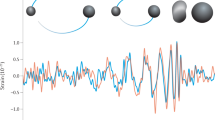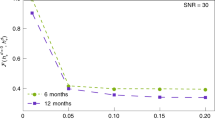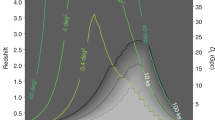Abstract
It has been reported1 that an observed 160-min solar oscillation may be caused by gravitational radiation from the intense γ-ray source Geminga, a source whose period according to the report is exactly one cycle per year different from the solar oscillation period. This remarkable coincidence has motivated us to look for a sinusoidal component having a period near 160min in Doppler data from the 1981 gravitational wave search with Pioneer 10. We find no such component in our most quiet data. Thus, the amplitude of a possible sinusoidal variation is no more than 3.3 × 10−14 in fractional Doppler frequency, which for the direction of Geminga translates into an upper bound of 2 × 10−14 for the polarization component of gravitational spatial strain potentially observable. This places rather stringent limits on the amount of gravitational radiation available to excite the 160-min normal mode of the Sun.
This is a preview of subscription content, access via your institution
Access options
Subscribe to this journal
Receive 51 print issues and online access
$199.00 per year
only $3.90 per issue
Buy this article
- Purchase on Springer Link
- Instant access to full article PDF
Prices may be subject to local taxes which are calculated during checkout
Similar content being viewed by others
References
Walgate, R. Nature 305, 665 (1983).
Wahlquist, H. D., Anderson, J. D., Estabrook, F. B. & Thorne, K. S. Atti Conv. Lincei 34, 335–350 (1977).
Estabrook, F. B., Hellings, R. W., Wahlquist, H. D. & Wolff, R. S. in Sources of Gravitational Radiation (ed. Smarr, L.) 37–48 (Cambridge University Press, London and New York, 1979).
Anderson, J. D., Armstrong, J. W. & Estabrook, F. B. in Proc. 13th A. Precise Time and Time Interval (PTTI) Applications and Planning Meet., 757–766 (NASA Conf. Publ. 2220, 1982).
Estabrook, F. B. & Wahlquist, H. D. Gen. Relativity Gravitation 6, 439–447 (1975).
Hellings, R. W., Callahan, P. S., Anderson, J. D. & Moffet, A. T. Phys. Rev. D23, 844–851 (1981).
Scherrer, P. H. & Wilcox, J. M. Sol. Phys. 82, 37–42 (1983).
Peters, P. C. & Mathews, J. Phys. Rev. 131, 435–439 (1963).
Damour, T. Phys. Rev. Lett. 51, 1019–1021 (1983).
Wahlquist, H. D. in Proc. 10th int. Conf. on GRG (ed. Bertotti, B.) (Consiglio Nazionale della Ricerche, Rome, in the press).
Bond, J. R. & Carr, B. J. Preprint RIFP-515 Research Institute for Fundamental Physics, Kyoto (1983).
Bignami, G. F., Caraveo, P. A. & Lamb, R. C. Astrophys. J. Lett. 272, L9–L13 (1983).
Author information
Authors and Affiliations
Rights and permissions
About this article
Cite this article
Anderson, J., Armstrong, J., Estabrook, F. et al. Pioneer 10 search for gravitational waves—no evidence for coherent radiation from Geminga. Nature 308, 158–160 (1984). https://doi.org/10.1038/308158a0
Received:
Accepted:
Issue Date:
DOI: https://doi.org/10.1038/308158a0
This article is cited by
-
Absolute astronomical accelerometry
Astrophysics and Space Science (1985)
-
Is Geminga a very close neutron star binary?
Nature (1984)
Comments
By submitting a comment you agree to abide by our Terms and Community Guidelines. If you find something abusive or that does not comply with our terms or guidelines please flag it as inappropriate.



